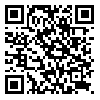BibTeX | RIS | EndNote | Medlars | ProCite | Reference Manager | RefWorks
Send citation to:
URL: http://sjsph.tums.ac.ir/article-1-261-en.html
Toxoplasmosis is a zoonosis of broad geographic distribution. This disease is caused by infection with the protozoan parasite Toxoplasma gondii. The most important ways to diagnose the disease are the serological techniques such as IFA and ELISA. The aim of this consideration, was comparison between the two methods, IFA and ELISA, in order to determine the incidence of antibody against Toxoplasma in pregnant women. In this descriptive-cross sectional study, from 600 pregnant woman whom have referred to Alzzahra and Izadi maternity hospitals of Qom, during four months (from Sep.2001 to Jan.2002), the specimen of blood have been prepared. After bloodletting and parting of serum, IFA and ELISA have tested its specimens. From 600 specimens of serum, from the tested mothers by IgG-ELISA method, 257 individuals (%42.8) and by IgG-IFA method, 246 individuals (%41) had Specific IgG antibody. Also, The comparison between the two methods, IFA and ELISA, demonstrates that 246 cases (%41) were positive in both methods, and 343 cases (%57.2) were negative in both methods, and only 11 cases (%1.8) were positive in ELISA and negative in IFA technique. In this study, the effect of different factors has been studied, in which deal with the prevalence rate of Toxoplasma infection. Although, these results shows that transmission of Toxoplasma infection in this city, like other parts of world and Iran has been done, but considerable percent of pregnant women (%57.2 by ELISA method and %59 by IFA method) lacking any type of acquired immunity against of this infection. Therefore, considering secure status and accomplishing exclusive experiments before marriage and also training and informing the people of region especially pregnant women with educational programs and supervision in pregnant period is necessary. On the other hand, with regard to the rate of concordance of the two tests (%98.2), The ELISA because of its high sensitivity and specificity, easier technique and lower expense it is preferred in order to screening Toxoplasma infection.
| Rights and permissions | |
 |
This work is licensed under a Creative Commons Attribution-NonCommercial 4.0 International License. |





